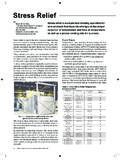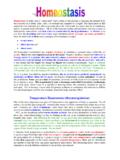Transcription of BASIC HEAT TRANSFER AND SOME …
1 1 BASIC heat TRANSFER AND some applications IN POLYMER PROCESSING (A version of this was published as a book chapter in Plastics Technician s Toolbox, Volume 2, Pages 21-33, SPE 2002) John Vlachopoulos and David Strutt heat TRANSFER is a branch of engineering science which seeks to determine the rate of energy TRANSFER between bodies as a result of temperature differences. The concept of rate is the BASIC difference between heat TRANSFER and thermodynamics. Thermodynamics deals with systems in equilibrium and is concerned with the amount of heat required to change a system from one state to another. Thermodynamics does not answer the question of how fast a change is accomplished. It is the science of heat TRANSFER that deals with this question. BASIC CONCEPTS The terms temperature and heat are understood intuitively.
2 Temperature is the physical property that describes whether a body is hot or cold . If we touch a hot metal at 120 F (49 C) heat flows from the metal to our hand. If we touch a cold block of ice heat will flow from our hand to the ice. So, the intuitive concept of temperature is really defined by the heat exchange from one body to another. heat is a form of energy that flows from one body to another as a result of a temperature difference. The two temperature scales used for measurement purposes are the Fahrenheit ( F) and Celsius ( C) scales. These scales were established by specifying the number of increments between the freezing (32 F, 0 C) and boiling point (212 F, 100 C) of water at standard atmospheric pressure. The absolute Celsius scale is called the Kelvin (K) and the absolute Fahrenheit scale is termed Rankine (R).
3 The following conversion relations apply + C =K + F = RK 59 = R32) - F( 95 = CC 59 + 32 = F In other words, 0 degrees R = F and 0 degrees K = C (absolute zero). Temperature is measured by observing its effect on some easily observable property of a measuring device expansion of mercury in a glass thermometer. 2 heat , or energy in general, is usually measured in Btu, cal, kcal and Joule (J). 1 Btu will raise 1 lbm of water 1 F at 68 F, 1 cal will raise 1 g of water 1 C at 20 C, 1 kcal will raise 1 kg of water 1 C at 20 C. The definition of Joule (J) comes from the definition of work done by a force on an object: (Newton meter = N m = J) Work W = F S where F is the force and S the distance travelled. Power is the work done per second and J/s is called Watt (W) V F = tS F =Power where t is time and V the velocity of travel.
4 If we multiply Watts by time, the result is work done. The work done by electricity is usually expressed as kilowatt hours, 1000 Watts times 3600 seconds, or 106 Joules. The following conversion relations apply: 1 Btu = 1055 J 1 kcal = 4182 J 1 Btu = 252 cal Btu/hr = sJ 1 = W 1 The human metabolism requires about 2500 kcal per day (roughly 400 Btu per hour) according to frequently quoted guidelines for daily food consumption. FUNDAMENTAL THERMODYNAMIC LAWS The First Law of Thermodynamics is the principle of conservation of energy, which states that energy cannot be created nor destroyed. A more technical definition is: The increase of internal energy ( E) of a given system is equal to heat (Q) absorbed from the surroundings plus the mechanical work (W) added. Q + W = E If no heat enters or leaves the system the process is referred to as adiabatic thus E = W 3 On the other hand, if no work is done by the surroundings, then E = Q heat and work are different types of energy.
5 heat capacity Cp (also called Specific heat ) is the amount of heat required to raise the temperature of a body by one degree. Here are some typical values: Water (at 20 C, 68 F) = 1 kcal/kg C = 4182 J/kg C Air (approximately) = kcal/kg C = 1000 J/kg C Polyethylene (approximately) = kcal/ C = 2300 J/kg C Steel (approximately) = kcal/ C = 450 J/kg C Brick (approximately) = kcal/ C = 900 J/kg C For a melting of a solid heat must be added to shake and demolish the crystal structure present. heat of fusion ( Hf) is the amount of heat required to melt a crystalline solid without raising its temperature. It is equal in magnitude (but opposite in sign) to the heat of crystallization. Here are some typical values: Ice Hf = 333,000 J/kg = (80 kcal/kg) This means that to melt 1 kg of water we need the same amount of energy as that required to raise 1 kg of water by 80 C, and yet with the actual melting, there is no increase in temperature.
6 HDPE Hf = 250,000 J/kg LDPE = Hf = 200,000 J/kg For amorphous polymers like PS, PMMA and PC Hf = 0, since they do not have any crystal structure. heat of reaction is the amount of heat involved in a chemical reaction (added or removed). All polymerization reactions (production of polymers) are exothermic, they involve liberation of heat . The Second Law of Thermodynamics relates to the direction in which energy TRANSFER or conversion may take place. The result is the increase of Entropy, which is a loss in the availability of energy for external purposes. heat will flow from a high temperature to a low temperature. It is impossible to construct a machine or device which will operate continuously by receiving heat from just a single reservoir and producing work. A heat engine is a device that produces net positive work as a result of heat TRANSFER from a high-temperature body to a low-temperature body.
7 The thermal efficiency of such engines is defined as the ratio of output (energy sought) to the input (energy that costs). The input or the energy that costs is the heat from the high temperature source (indirectly, the cost for the fuel) We define thermal efficiency as 4 )costs that energy( Qsought)W(energy = efficiency Thermal The efficiency of heat engines is higher if the heat source has higher temperature. However, all such actual devices have low efficiencies ( combustion engines for cars, no more than 35%). In other words, only about 1/3 of the energy in gasoline goes to useful work (motion of the car). The rest is wasted due to thermodynamic implications. This is the reason why there is so much research on fuel cells nowadays, in which fuels react with oxygen to produce electricity, at higher efficiencies (50 60%).
8 For more information on the thermodynamic laws and their implications the reader is referred to more specialized textbooks [1-3]. Example 1 Thirty people gather for a cocktail party in a basement room that can be assumed completely sealed off and insulated. The room dimensions are 24 ft 28 ft with 8 ft ceiling. Calculate the temperature rise in 30 minutes. Solution We apply the first law of thermodynamics Q + W = E Since there is no work being added to the air in the room E = Q We will assume that each person gives off approximately 2500 kcal/day (equal to the average metabolic energy consumption for light activity, like talking and walking around the room) E = Q = 30 2500 = 75,000 kcal/day = 3125 kcal/hour = 52 kcal/min This amount of energy goes to the air inside the room which is roughly Air volume = 24 ft 28 ft 8 ft = 5376 ft3 = m3 We neglect the volume occupied by the people.
9 The density of air is about kg/m3. So the total mass of air in the room is m = = kg. The internal energy change will be 5 E = m Cp T where Cp is the heat capacity of air ( kcal/ C). min / =min / = Ckcal/kg kg 52 = C mE = Tp So, in 30 minutes the temperature would rise by 30 C/min = C ( F)! This means that even a cold room would become quickly very hot, if the assumption of complete insulation is valid. In reality, there would be considerable heat losses to the surroundings that will slow down the temperature rise. Example 2 In an injection molding machine 20 kg of LDPE are molded per hour. The melt temperature entering the mold is 180 C and the mold temperature is maintained at 40 C by a cooling water system. Determine the amount of water required to cool the plastic and keep the mold at 40 C, if the difference in input-output temperatures of the water is not to exceed 5 C.
10 Solution This is a straightforward application of the first law of thermodynamics, that is the principle of conservation of energy. The heat for coming off the solidifying plastic in the mold must be taken away by the water. Qplastic = Qwater The heat removed from the plastic is equal to the heat given off as the plastic temperature drops from 180 C to 40 C plus the heat of solidification which is equal to the heat of fusion but opposite in sign. As the plastic solidifies and the molecules stop moving randomly, heat is liberated. H m + T c m = Qfpplastic m is amount of material molded per hour, Cp its heat capacity and Hf the heat of solidification (200,000 J/kg for LDPE which solidifies around 106 C). sJ 2900 = 1111 + 1789 = J/kg ,000020 s3600hr hrkg 20 + C)40-(180 CkgJ 2300 s3600hr hrkg 20 =Qplastic The heat taken up by the water undergoing a 5 C temperature change is 6 20910 m = C5 CkgJ 4182 m = T c m = Qpwater Therefore, kg/hr 499 = kg/s = msJ 2900 = kgJ 20910 m For another example of cooling of a plastic in a mold the reader is referred to the last section of this chapter: Special heat TRANSFER Problems in Plastics Processing.







